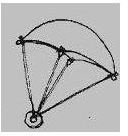Making a Handkerchief Parachute: Fun Science Experiment
The Experiment
This experiment lets you develop a parachute of your own. It won’t be big enough for personal use, but it will help to demonstrate the principles behind a parachute.
Materials
- Large handkerchief
- 4 strings of strong thread
- A small weight (a toy soldier would do the trick)
**
Procedure
Take each corner of the handkerchief one by one and tie one end of a thread to it securely. Tie the other end to the weight or the toy-man.
Repeat the same for all the remaining three corners.
Make sure that when you hold the handkerchief from the mid-point, the length of all threads should be approximately the same. Otherwise they may affect the performance of the parachute.
Stand in open ground, fold the handkerchief over the weight and hurl it with full force as high as you can. If everything works fine, the weight will come down slowly as if floating in the air, rather than abruptly falling down under gravity.
Explanation
The science behind this phenomenon is very simple. When an object moves through air it experiences resistance to its motion. This resistance depends on a lot of factors including the surface area of the object exposed to the atmosphere. This is exactly the reason why cars and other fast moving vehicles are given a streamline shape so that air resistance is reduced to minimum possible level.
When the weight goes up and begins to fall down, the bulky weight falls ahead of the light handkerchief. The handkerchief gets inflated with air as shown in the figure above. Since now the handkerchief is not folded any more but fully spread out, its surface area is increased which causes a lot of resistance to its downward motion. At the same time, the weight of the object is acting downward including the weight of the handkerchief (however small). This causes the parachute to slowly float down rather than dropping immediately.
